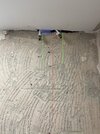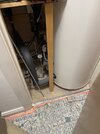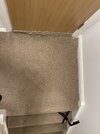Hi guys,
Question for you experts out there.
I am seeking to trace this wall to bury the pipes for a shower but have hit a snag.
The picture I uploaded shows the centre line (red) and green lines show roughly where the pipes need to come down. The left pipe however can't come over anymore as there's a joist in the way (blue). I am toying with a few ideas but I'd like to hear what you guys suggest?
*I plan to cut a piece out of the plasterboard ceiling and replace it as it literally crumbled when I removed the tiles.
As always, thanks.
Question for you experts out there.
I am seeking to trace this wall to bury the pipes for a shower but have hit a snag.
The picture I uploaded shows the centre line (red) and green lines show roughly where the pipes need to come down. The left pipe however can't come over anymore as there's a joist in the way (blue). I am toying with a few ideas but I'd like to hear what you guys suggest?
*I plan to cut a piece out of the plasterboard ceiling and replace it as it literally crumbled when I removed the tiles.
As always, thanks.




